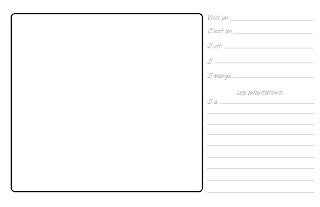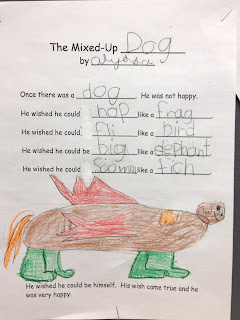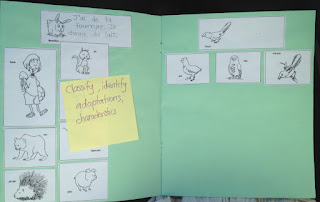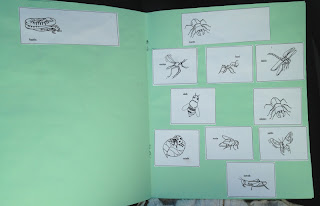Shannon has posted a project format for this unit on her blog. Click here to see the format and template. This is the second post of the project. It's suitable for grades 1 and 2.
The Needs of Plants and Animals - Adaptations
Here is a booklet students can complete that covers different animal adaptations and habitats. It is differentiated to meet different needs. The first version is just text and students add the correct animal picture. The next one asks students to cut and glue that correct animal name and picture. The last one has the animal name in dotted lines for students to simply match the animal name to the right page.
les habitats.pdf
I have a Needs of Plants and Animals SMARTboard activity as well. It's prompted some really good discussion in my class! (But that animal can be wild or domestic, Madame! Those berries aren't living anymore because they aren't on the bush, Madame!) LOVE it! I threw it up onto the SMARTboard activities page but I'll add it here as well.
Besoin des plantes et animaux.notebook
We are spending the month of April discussing plants and reading A Tiny Seed by Eric Carle and a few versions of Jacques et le haricot magique. Here is a SMARTboard activity covering several aspects of plants such as plant parts, plant functions et plant needs. I have also converted this file to a PDF so those without Notebook.
Les Plantes.notebook
Les plantes pdf.pdf
When I did some seed planting this year to coincide with reading Jack and the Beanstalk and A Tiny Seed, I decided to work in some centres. One of our centres was this sheet where students had to create a similar sheet drawing what they think the seeds will become.

This is an art/science project we completed about a week ago. Since we have been talking about plants and their parts and functions, we made and labelled this cute flower. Below the picture are the labels.

etiquettes pour les plantes.pdf
We did this activity to tie in some math when we were working on some higher numbers. Students traced their hand and arm, crumpled up tissue paper and counted how many buds they had put on their tree.

spring jazzy journal.pdf
This was our Earth Day art and writing project.

Ma promesse a la terre.doc

Here are the clear targets listed in "I can" statements for this unit of study taken from the Alberta Program of Study for Science. In retrospect I should also include the targets for other subject areas that this project will address. This sheet goes in an envelope on the back of the project/folder to be consulted during the project and once it is complete.
This an important communication piece for parents and self-evaluative piece for students. It clearly shows them what is being studied and what the expectations are. Students can identify where they are at in their learning.
I have left space to jot in which project or lesson addressed each outcome and space for teacher or student notes. This single project won't address every outcome.
As a planning tool I plot out on this sheet how many weeks each outcome or project might take to investigate - it's the beginning of a long range plan.

"Les adaptations" word strips (printable)
We first used this vocabulary during journal writing, even before the science unit had started. Students had written "Qui suis-je" sentences about one another describing one another's clothing and physical characteristics. The class had to guess who the student was describing.

Our next step was to write "Qui suis-je" clues about animals. Once again students would share their's with the class and we would guess the animal. By the time we were ready for our unit about animal needs and adaptations students were familiar with the vocabulary of animal adaptations.

"Les animaux" word strips (printable) from Sparkle Box
Animal Adaptations Rap Video (in English)
Gives a quick overview of examples of adaptations of a camel.

Students invent an animal (draw, paint, build with clay, create on Show Me App) and use this template and sentence prompts (if needed) to describe the creature and it's adaptations. Students can be challenged with a problem their creature needs to solve ie, it must be a pollinator, a creature that will control a pest problem (mosquitoes?) etc.

If you are economizing on copies this template may be better (2 per sheet). It can also accompany multimedia animals that may not be 2D

This document is purposefully similar to the timeline project students completed earlier in the year. The template is another familiar way students can record their learning.


Léon le caméléon de Mélanie Watt - Léon n'est pas un caméléon comme les autres : il ne peut pas se camoufler. Dès qu'il se tient sur quelque chose, il devient de la couleur opposée.
Le caméléon méli-mélo de Eric Carle - La vie du caméléon n'est pas très passionnante jusqu'au jour où il découvre qu'il peut non seulement changer de couleur, mais aussi de taille et de forme.

After reading the mixed-up chameleon grade 1 student in the English program invented these animals. The FI students had learned about animal adaptations and had used this vocabulary to write "who Am I" statements in their journals. They were familiar with this vocabulary and could use it to describe the adaptations of their invented animals.


Project Noah is a web tool and iPad app to explore and document wildlife and a platform to harness the power of citizen scientists everywhere. Your class can track and earn badges as they post spottings of local animals. Students can log into the account and add any animal they find, very easy to start up and maintain for the duration of a unit of learning. Beware, students will want to continue to track local wildlife with this tool long after your unit of study is complete. English only, perhaps home/school learning tool?
Eric Carle's story "The Mixed Up Chameleon" (English).

Students decide how they'll sort or classify their animal collection. Here are a few ideas or headings they may use, either in a folder as above, a flipable, or a booklet.



A few ways we classified animals. I found it best to stick to the learning outcome suggestion that students sort by visible characteristics.


Some students wanted to sort their animals as mammal, reptile and so on in a booklet. These photos are my moc-ups. I always try out the project first to see what students might need. Students also added their own drawn animals, animals they found in magazines, pictures their friends had drawn, their pets. I forgot to photograph the student booklets.

We wrote some characteristics of each group of animal together as you can see on the mammal heading with the rabbit on it.


Comments (3)
lenaz said
at 8:18 am on Apr 16, 2012
Do you by any chance have the Plant notebook file as a pdf as well? I would love to have a look at it but I don't have any of the SMARTboard software on my computer....
Jackie Astrom said
at 9:24 pm on Apr 16, 2012
Hi lenaz,
I converted the file (a first for me!) so I hope that works. Let me know if there are other files you would like to see as a PDF. Thanks!
Jackie
lenaz said
at 11:01 pm on Apr 16, 2012
C'est super!! Merci beaucoup. I'm definitely looking forward to having a SMARTboard someday :).
You don't have permission to comment on this page.